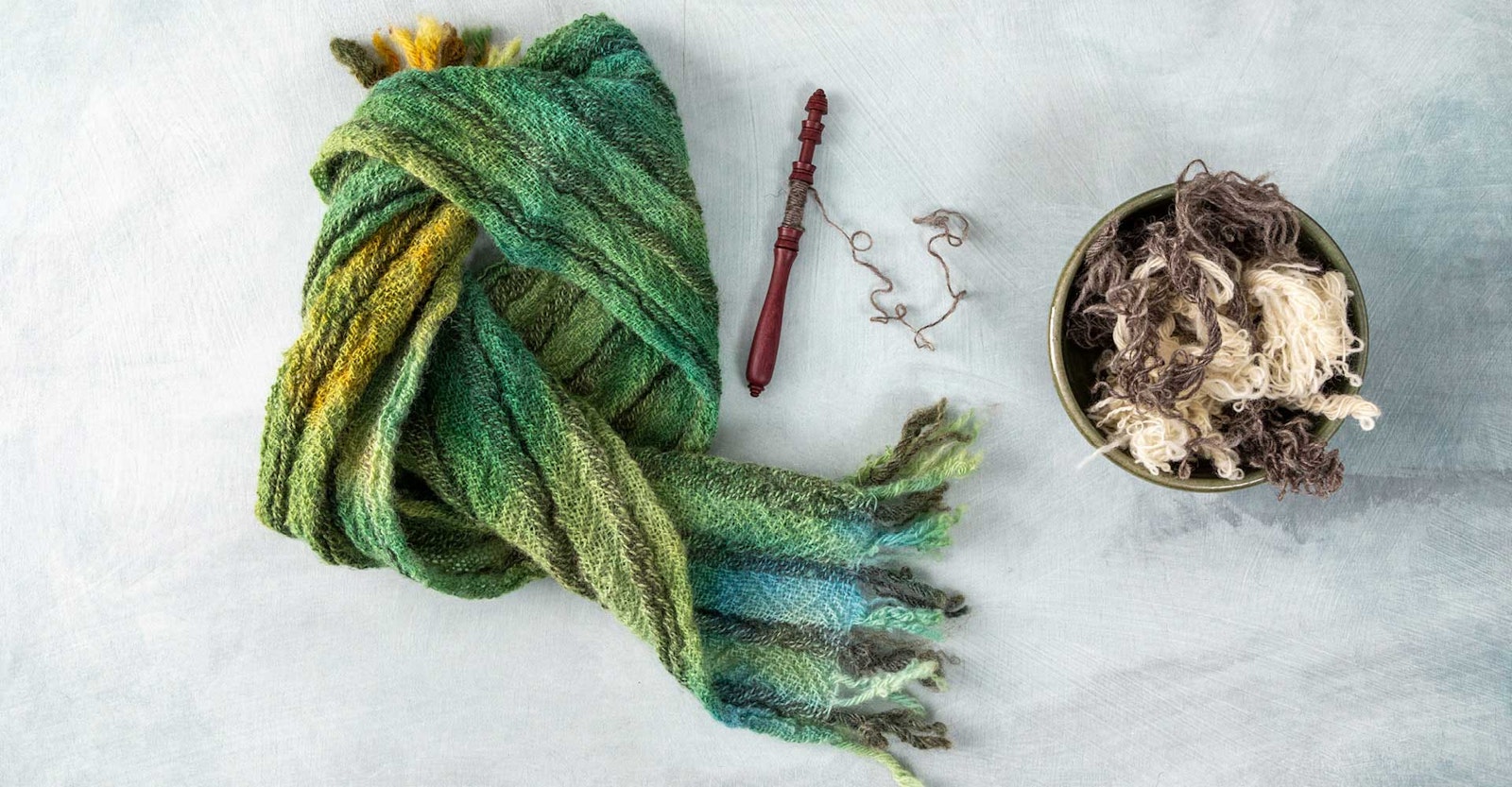There are many ways to create texture in weaving, which—in addition to color and pattern—can add a lot of interest to handwoven fabric. Broadly categorized, these methods are:
- Weaving a structure that creates texture naturally, such as waffle weave or deflected doubleweave.
- Encouraging differential shrinkage by weaving with yarns that full and those that do not.
- Using energized or active-twist yarns—which include high-twist yarns and man-made elasticized yarns—either alone or together with inactive-twist yarns.
For handspinners, it’s easy to create high-twist yarns; we simply add more twist to a singles or plied yarn than we would if creating a balanced yarn. These high-twist yarns may look neat and tidy on the bobbin, but once let loose, they are unruly, earning the common appellation “energized yarns.” We fine-tune this energizing process by adjusting how much twist and in what direction we are inserting twist.
A note here: handweavers often use the term “collapse weave” when talking about textured fabrics. This is a misnomer because collapse weave is not a weave structure at all. I prefer using the term “collapse fabric” to describe handwoven cloth that pushes away the grid of traditional weaving, having rounded shapes, curves, and depth that can be achieved by using one of several methods.

Detail of tracking in plain weave. Notice how the weft yarns untwist slightly and curve away from the fabric, creating a diagonal line and a look that mimics woven twill.
Weaving with High-Twist Yarns
Handwovens with collapse effects can be created with high-twist singles because the energy stored in the yarn creates pleats and poufs in the finished cloth. While on the loom, the high-twist yarns are held under tension. Off the loom and when wet-finished, the S-twist yarns will create folds in the fabric, releasing their overtwisted energy to loosen the S-twist. The Z-twist yarns will do the same thing but create folds that move in the opposite direction, allowing the yarn to relax to create a looser, more steeply angled Z-twist.
Your job as a weaver is to keep these highly twisted yarns under tension as much as possible throughout the process of winding the warp, dressing the loom, and weaving the fabric. The other major factor in creating textured fabric is using a wide sett—wider than is normally recommended for plain weave—and a loose beat to produce a balanced weave. You want the yarns to have plenty of space to move about, relax, and loosen up. I liken this technique to raising teenagers: Give them plenty of structure, and they are less apt to misbehave, but with a loose structure, they can really act up!
More often than not, you won’t see the textured effects when the fabric is under tension on the loom. But in the wash with a bit of detergent, hot water, and agitation, the fabric will change dramatically and—to my eye—magically. It’s the texture in textiles that fascinates me. Of course, I find the colors and patterns delightful and intriguing, too, but the tactile aspect and the way that fibers reveal depth and substance never fail to draw me in.

When tension is relaxed on the warp, the high-twist singles will look like a tangled mess. With good warping technique, the singles will stretch back out in an orderly fashion when under tension. Photo by Denise Bolger Kovnat
Pleated Scarves
For both the green Romney Pleated Scarf and the Alpaca Pleated Scarf, I created fabrics with vertical pleats using overtwisted singles. The warps had alternating stripes of S- and Z-twist singles. The stripes don’t have to be different colors, but I like the effect. Both scarves are woven in plain weave with wefts of Z-twist singles and warps of alternating S and Z singles.

Current subscribers to Spin Off can find instructions for the Alpaca Pleated Scarf on our website; find the link below.
Alternate Method: Bumps
For similar projects in the past, I wove bumps rather than pleats. Using overtwisted yarns for the warp and weft in plain weave, weave horizontal stripes and alternate between a group of picks (weft beats) with S-twist singles and a group of picks with Z-twist singles. It may not look like much on the loom, and in fact, your fabric will look like gauze because your sett and beat need to be loose, but after washing, your fabric will have lots of poufs and puckers.
Alternate Method: Tracking
Another way that handspun overtwisted singles can be used to create texture in weaving is called tracking. Most often appearing in plain-weave fabrics, tracking develops after washing, when yarns relax and unwind into a looser ply with a steeper angle. Given enough room in the beat (how you pack in the weft with your loom’s beater) and the sett (the number of yarns per inch in the warp), your weft yarns will curve rhythmically, creating the illusion of a twill pattern and, frustrating for weavers, sometimes competing with the design. But in this case, tracking is desirable!
Current subscribers to Spin Off can access the Alpaca Pleated Scarf pattern here.
Denise Bolger Kovnat weaves and teaches from her home in Rochester, New York, focusing on collapse techniques, echo, jin, extended parallel threadings, warp painting, and deflected doubleweave. She blogs about her work at www.denisekovnat.com.
This article first appeared in Spin Off Summer 2021.

